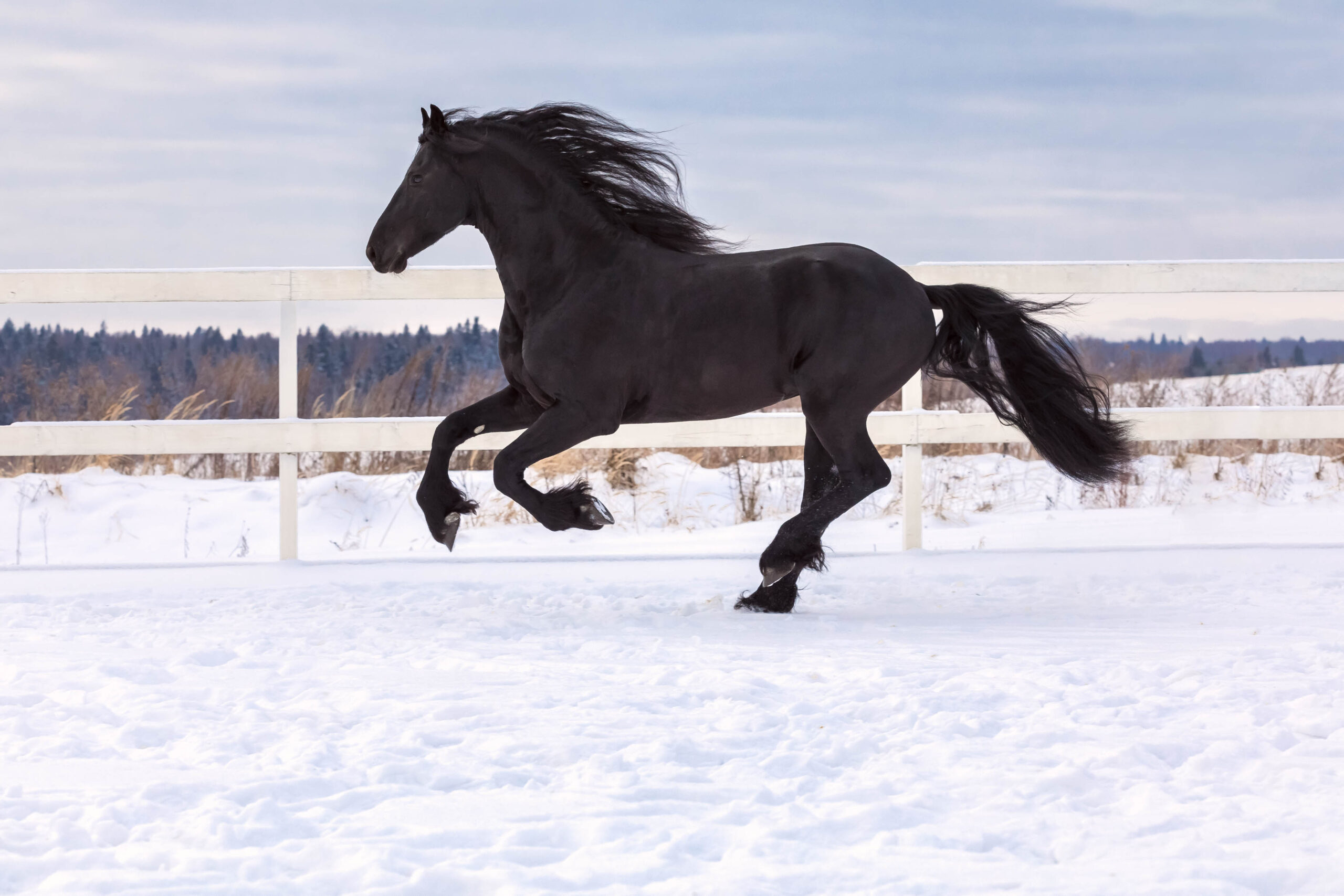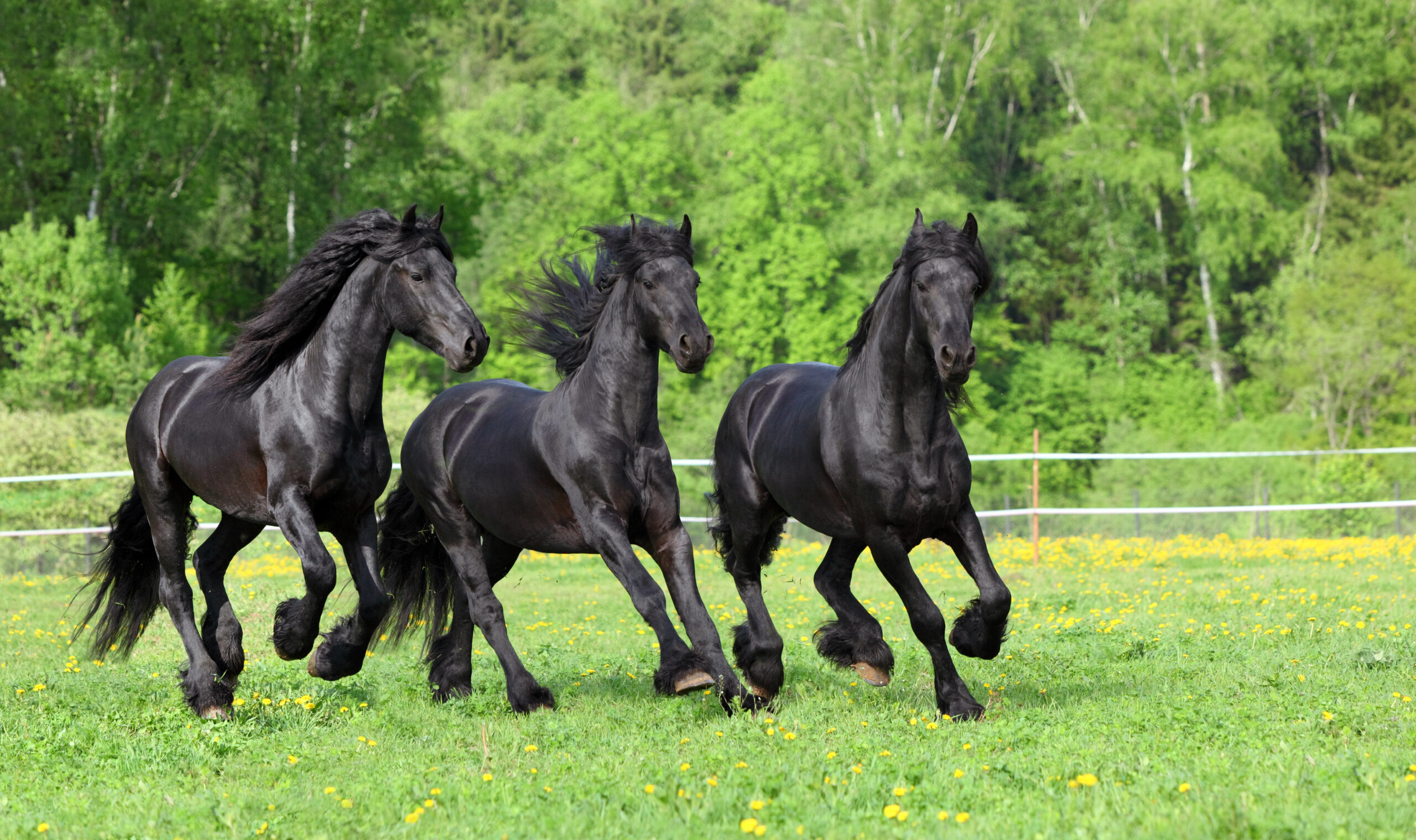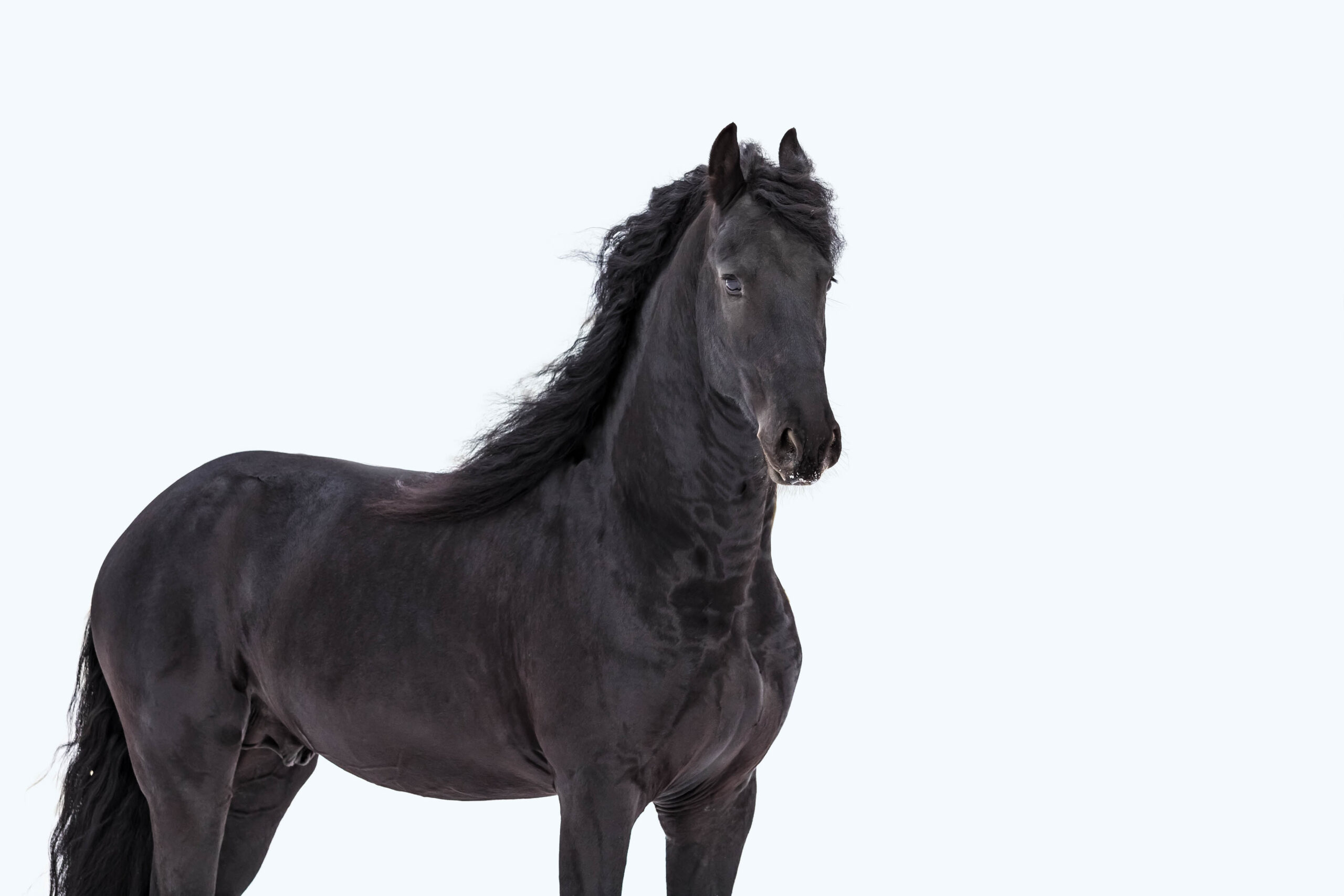A Friesian Horse showing off its paces is a stirring sight. The combination of high head carriage, thundering hooves, and full, flowing mane and tail creates a spectacle that’s hard to beat. It’s no wonder they are one of the breeds that are most popular in the media. There’s an almost fairy tale quality about the lovely Friesian Horse.
Friesian Horse – History and Origins
Friesian Horses take their name from the Netherlands province of Friesland. In Roman times, the region was known as Frisia, and the writer Vegetius commented that horses from this area were of good quality. Mounted troops from this low-lying region were stationed on Hadrian’s Wall in Britain. Some writers later speculated a relationship between the Fell pony of Cumbria and the Friesian on the basis of similarity in appearance. Both breeds have full, flowing manes and tails, with plenty of feathering on the legs, and many Fell Ponies are black, making them superficially similar. Also, both are prized for the quality of their trot.
While this theory is still popular among some researchers, it is not promoted by the Fell Pony Society. In any case, it is unlikely that either the ancestors of the Fell or the Friesian looked exactly like their modern descendants. However, burials of horses belonging to the tribe called the Frisii who occupied this region have been found in the Netherlands. They were small animals about 13.2 hands high (54 inches/137 cm), which is somewhat below the standard for Roman war horses at this time. It has also been suggested that the medieval ancestors of the Friesian were war horses, which is certainly possible, though again much of the evidence is speculative. Some war horses did increase in height, particularly in later medieval times. During this period, a lot of horse breeding was carried out by monasteries, including those in Frisia.
Are Friesian Horses good for beginners?
Friesians can be docile, willing, and quick to learn. However, as they are large, powerful horses that need the right training and a job to do, they are not necessarily best for beginners. Plus, purchasing a Friesian is a substantial outlay. They require constant well-informed care to maintain their coats, manes, and tails.
A Baroque Breed Emerges
In the fourteenth and fifteenth centuries, political changes meant that the Netherlands came into the sphere of the Habsburgs. This was the period of the greatest influence of the Baroque Spanish Horse. Now images of the Friesian, or rather Frisian horse, began to look more like the Friesian we know today, with a thick, curling mane and powerful build. The Friesian, under the name of the Friezeland Horse, was mentioned by the writer Thomas Blundeville in 1561. This author described the horses as being not very tall, but strong and compact, swift runners, and good trotters. Blundeville continued that they had lots of stamina over longer courses. He also said that some of them would make good horses for the “manege,” in other words, for the kind of exercises that would later be associated with dressage.
However, he also suggested that they needed bold, understanding riders, and could easily lose confidence and become difficult if they were badly managed. As Oriental breeds, such as the Turkoman, became popular, they too influenced the Friesian, as did the Thoroughbred. Finally, in the eighteenth and nineteenth centuries, the Friesian was the great agricultural all-rounder, capable of working on the farm as well as taking part in spectacular trotting races. They were becoming less popular as riding horses at this time but were renowned driving horses. The first studbook, known as the Fries Rundvee Stamboek, was founded in 1879. Later, in 1880, the Paardenstamboek contained not only the registry of Friesian Horses but also heavy warmblood breeds.
Both Frisian cattle and Frisian horses, increasingly known as Friesian, were markers of regional identity. However, in the early twentieth century, like many other horse breeds, the Friesian was in decline and might very well have disappeared altogether. There were very few stallions left. Then, due to recognition of both its qualities and its importance as a heritage breed, the Friesian came back from the brink. Now it is increasingly popular all over the world. Today, registrations are made in the Koninklijke Vereniging Het Friesch Paarden-Stamboek (KFPS). Any breeding of Friesian stallions and mares should be registered with this horse association directly or through its affiliates.

The modern Friesian is a tall horse, with stallions generally standing between mimimum15.3 hands (63 inches/160 cm) and 17 hands (68 inches/173 cm) high
Conformation of a Friesian Horse
The modern Friesian is a tall horse, with stallions generally standing between 15.3 hands (63 inches/160 cm) and 17 hands (68 inches/173 cm) high. While smaller animals are known, in order to gain the coveted “star-designation” in the KFPS registry, mares or geldings must be a minimum height of 15.2 hands (62 inches/157 cm). They are nearly always black, with very little white (just a small star) permitted. Chestnut and bay Friesians do exist, but they are excluded from several registries.
There are variations within the breed, due to modern preferences for two distinct types. One type has a more traditional Baroque appearance, which is closer in form to that of its Spanish relatives. The other has developed into a sport horse type to meet the needs of modern showing and other equestrian activities. In both cases, the bodies are powerful and compact with visible musculature. The legs are short and strong. The sports type tends to be finer than the substantial bone structure of the classical Baroque Friesian. For carriage driving, Friesians with elevated head carriage and an active, eye-catching trot are favored. The mane and tail are often notably wavy. The full mane gives the noble head of the Friesian its distinctly Baroque look. They also have full, silky feathers on the legs. The mane, tail, and feathers of the Friesian are a major part of its appeal and should always be maintained in as full and long a condition as possible.
Video of Friesian horses
Characteristics of the Friesian Horse
Friesians developed from stock that was used for a variety of purposes. While they certainly look gorgeous, they are no lightweights in strength and character. Their power should not be underestimated. Essentially, they are working horses. They can be categorized as general-purpose horses, and also as light draft, or heavy carriage horses. This means they need to be in work to maintain their health, confidence, and out-going attitude. They also tend to suffer from various issues, from skin complaints, such as pastern dermatopathy, to a greater tendency to colic than other horses. Keeping a Friesian can be challenging but is also very rewarding.
Breeding and Uses
The standards for breeding Friesians are strictly overseen by the KFPS and its global affiliates. Operating the predicate system, outlined below, ensures that quality is maintained, and the standards are adhered to across the globe. Today, Friesians can be seen showing off their stunning paces in the dressage arena. They star in driving classes, too, which is one of their most important talents. Friesians participate in every kind of driving, from marathons to show driving. They can also be seen in their heritage role, drawing the traditional high-wheeled cart called a sjees. This tall vehicle is designed to show off both the driver and horse and travels along the road at a great speed. Historically, they were often highly decorated.
They were actually an early type of convertible – not quite in the automobile sense, though! They could easily be converted to be drawn by one Friesian Horse or by a pair. Plus, of course, Friesians are outstanding parade and show horses. Best of all, they are the stunning stars of many TV shows and movies. Their popularity in the USA is believed to date to the movie Ladyhawke in 1985. A Friesian was the perfect equine star to play Tornado in the Mask of Zorro and the Legend of Zorro, and of course, the noble Friesian Wabe was the ideal mount for Prince Caspian in the second Chronicles of Narnia movie. It’s not surprising that the breed is also popular for jousting and re-enactment. Friesian Horses have also been used to create the Warlander breed, an ideal choice as a horse for use in the media and by re-enactors

Friesians are versatile horses. Originally they were intended as driving horses. Nowadays they can also be seen in dressage.
Friesian Predicates
The KFPS, the dedicated studbook for the Friesian Horse, uses the predicate approach for recognizing and categorizing the breed. These are essentially recognitions of quality and achievement, similar to a grading system. The KFPS system is comprehensive, including performance, conformation, and, in the case of stallions and mares, the performance of their youngstock. The Predicates are as follows:
- Ster (Star): The parameters for gaining the Star predicate are based on height, movement, and conformation/appearance. They are awarded to stallions, mares, and geldings, after inspections when they are three years old. The Star can be awarded to Studbook mares, Gelding Book geldings, and Foal Book stallions, which are already registered, or upon entry into the Studbook. Subsequently gelding a star-rated stallion does not result in the loss of the Predicate.
- Kroon (Crown): This is an award for mares of 3 years and over. They must be of exceptional quality to gain this accolade. The parameters vary from country to country. In the Netherlands, the mare should have received a Breeders’ Day premium. They are also tested on performance by the AFBP test. From this, the horse’s aptitude for dressage and/or as a harness horse for show driving or leisure driving can be assessed. The majority of mares are aged 3 to 5 at the time of this test. It also assesses their willingness and stable manners over a certain time period. As an alternative, the IBOP performance test for horses of 4 and over can be used to assess suitability in walk, trot, and as a dressage and/or harness horse. The AFBP test is only currently available in the Netherlands.
- Model: The Model predicate is a higher award for mares of “really exceptional quality” aged 7 years and over. Again, the parameters vary from country to country. In the Netherlands, the mare must have gained a Breeders’ Day first premium and also have a central inspection in the same year. In some countries, the Model mare must have suckled, or be suckling a foal. In the Netherlands, the mare must take an AFBP test within the same year and achieve a minimum number of points. Elsewhere, the mare will take an IBOP or similar test.
- Sport: The Sport predicate is open to stallions, mares, and geldings and relates to their performance in competitive sport. To qualify, the results must be obtained by shows that are registered with KNHS (Royal Dutch Equestrian Sport Federation). The results are based on performance in the following sports: dressage, show driving (with certain standards and a minimum number of placings), dressage in harness, and combined driving. Outside the Netherlands, standards are assessed by an inspection jury drawn from the KFPS Sports Committee.
What is the average cost of a Friesian Horse?
An average cost for a Friesian Horse is hard to estimate as it varies greatly according to the grading and intended use of the horse. Due to their relative rarity, and the fact they are greatly sought after, prices of Friesian Horses range from a minimum of around $3,000 to over $30,000. A good stud stallion will cost a minimum of $25,000 up to $100,000.
There are also two categories of preferant breeding stock:
- Preferant stallions: This status is based on the stallion scoring in excess of 1000 points on the quality of the youngstock they have sired. The points system is graded according to the grading of offspring, such as Ster, Kroon, Sport, Preferant mare, and so on. The temperament of the stallion and his overall contribution to the breed are also judged.
- Preferant mares: This ranking relates to the offspring of the mare, at least four of which should be high-ranking Ster, Kroon, or Model mares, geldings, or stallions, approved studbook stallions, and so on.
Finally, there is a special Performance Dam (Prestatie Moeder) predicate for mares with at least three offspring that have received the Sport predicate.

Friesians have long tails and manes. This must be groomed regularly.
USA-based Friesian Organizations:
In the United States, the Friesian Horse Association of North America (FHANA) represents the Netherlands studbook organization, the Friese Paarden Stamboek (FPS). There are now several other national and regional organizations. The FHANA is the best way to find out more about the predicate system.
Are Friesian Horses good for riding?
Friesian Horses, particularly the modern sports horse type, make great riding horses for many equestrian disciplines. The Baroque type can be an excellent choice for dressage. Friesians with elevated head carriage are best-suited to sports and leisure driving.
Grooming for Friesian Horses
Unsurprisingly, charismatic Friesian Horses are high on the wish list of many horse enthusiasts. It’s easy to fall in love with the beauty, charm, and talents of these wonderful animals. However, there’s no doubt that it takes a lot of work, specifically grooming, to keep them looking stunning. Would-be owners and riders should be prepared for lots of brushing, and also regular checking and washing of the leg feathers, which might show signs of underlying skin issues if not properly cared for. Most Friesian fans would say it’s well worth it, and it creates opportunities for bonding closely with their beloved animal.

